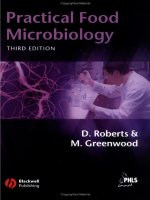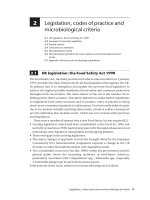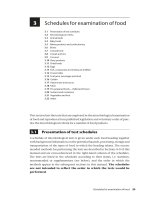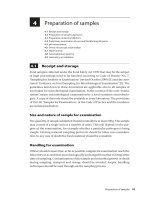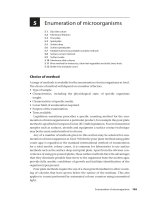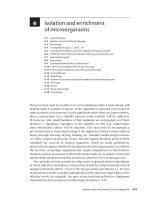Food flavorings (3rd edition)
Bạn đang xem bản rút gọn của tài liệu. Xem và tải ngay bản đầy đủ của tài liệu tại đây (18.66 MB, 492 trang )
Food Flavorings
Third Edition
Edited by
Philip R. Ashurst
Dr. RR. Ashurst & Associates
Kingstone, Hereford, United Kingdom
ANASPEN PUBLICATION®
Aspen Publishers, Inc.
Gaithersburg, Maryland
1999
The author has made every effort to ensure the accuracy of the information herein. However, appropriate information sources should be consulted, especially for new or unfamiliar procedures. It is the
responsibility of every practitioner to evaluate the appropriateness of a particular opinion in the context of actual clinical situations and with due considerations to new developments. The author, editors,
and the publisher cannot be held responsible for any typographical or other errors found in this book.
Aspen Publishers, Inc., is not affiliated with the American Society of Parenteral and Enteral Nutrition.
Library of Congress Cataloging-in-Publication Data
Food flavorings / edited by Philip R. Ashurst. — 3rd ed.
p.
cm.
ISBN 0-8342-1621-3
1. Flavoring essences. I. Ashurst, P. R.
TP450.F66 1999
664'.5—dc21
99-27422
CIP
Copyright © 1999 by Aspen Publishers, Inc.
A Walters Kluwer Company
www.aspenpublishers.com
All rights reserved.
Aspen Publishers, Inc. grants permission for photocopying for limited personal or internal use.
This consent does not extend to other kinds of copying, such as copying for general distribution,
for advertising or promotional purposes, for creating new collective works, or for resale.
For information, address Aspen Publishers, Inc., Permissions Department,
200 Orchard Ridge Drive, Suite 200, Gaithersburg, Maryland 20878.
Orders: (800) 638-8437
Customer Service: (800) 234-1660
About Aspen Publishers • For more than 35 years, Aspen has been a leading professional
publisher in a variety of disciplines. Aspen's vast information resources are available in both
print and electronic formats. We are committed to providing the highest quality information
available in the most appropriate format for our customers. Visit Aspen's Internet site for
more information resources, directories, articles, and a searchable version of Aspen's full catalog, including the most recent publications:
Aspen Publishers, Inc. • The hallmark of quality in publishing
Member of the worldwide Wolters Kluwer group.
Editorial Services: Ruth Bloom
Library of Congress Catalog Card Number: 99-27422
ISBN: 0-8342-1621-3
Printed in the United States of America
1 2 3 4 5
Contributors
Philip Ashurst, Ph.D.
Dr. RR. Ashurst & Associates
Kingstone
Hereford
United Kingdom
D.G. Ashwood
Burtons Gold Medal Biscuits
Quality House
Blackpool
United Kingdom
D. Bahri
Givaudan Aromen GmbH
Dortmund
Germany
Belayet H. Choudhury
Takasago International Corporation
(USA)
Rockeigh, New Jersey
D.C.F. Church
D.C. Flavours Ltd.
Clacton-on-Sea
Essex
United Kingdom
H. Kuentzel
Givaudan Research Company
Dubendorf
Switzerland
D. V. Lawrence
Flavex Ltd.
Kingstone
Hereford
United Kingdom
Charles H. Manley, Ph.D.
Takasago International Corporation
(U.S.A.)
Rockeigh, New Jersey
Giinter Matheis
Dragoco Gerberding & Co. AG
Holzminden
Germany
A.C. Mathews
Net Consultancy
Drake House
Cinderford
United Kingdom
Peter Mazeiko
Takasago International Corporation
(USA)
Rockeigh, New Jersey
David A. Moyler
Fuerst Day Lawson Ltd.
St. Katherines Way
London
United Kingdom
Roger N. Penn, Ph.D.
Director
Tobacco Business Unit
MANE
Bar-sur-Loup
France
Barry Taylor
Danisco Flavours
Dennington Industrial Estate
Wellingborough
Northhampton
United Kingdom
Geoff White
The Edlong Company
Martlesham Heath
Ipswich
Suffolk
United Kingdom
Suzanne White
The Edlong Company
Martlesham Heath
Ipswich
Suffolk
United Kingdom
John Wright
Bush Boake Allen Inc.
Montvale, New Jersey
Preface
It is almost a decade since the first edition of this volume was produced and
nearly 5 years from the second. Despite the many organizational changes that
have taken place in both the flavor and publishing businesses, it is again gratifying to find that the demand for a third edition remains.
This is in no small part due to the fact that the flavor industry continues to
flourish despite the takeovers and amalgamations that increase the size of the
major manufacturers. These activities tend inevitably to create a fallout of skilled
personnel, a proportion of whom restart in a small way and start the cycle all over
again.
The industry generally becomes more oriented to high technology operations,
although these generally impact more on the control of manufacture, sales and finance than on the actual creation of flavors themselves. The heart of a good flavor
remains the simple blending of high-quality ingredients to produce a creation that
is, to its user, more than the sum of its parts.
The industry continues to supply traditional demands for flavors in the food
industry—soft drinks, baking and confectionery—and at the same time to meet
the new challenges of ready-prepared meals and other new developments in products and processing.
For the first time, however, this third edition acknowledges the important contribution made by flavors to areas other than food. Flavors play a vital part in the
formulation, acceptability and, therefore, efficacy of most oral medicines—both
over-the-counter (OTC) and ethical preparations. A chapter on the use of flavors
in pharmaceutical applications deals with this subject.
Similarly, a chapter reflects the major use of flavors in tobacco products. Whatever the level of social acceptability of smoking, the subject is of great significance with the flavor industry.
Other new chapters deal with the important topics of flavor modifiers and the
whole realm of flavor quality control. Of the remaining contributions, some are
unchanged and others updated and amended.
Overall, it is hoped that readers will again find this to be a useful work. Its contributors are widely experienced and I am extremely grateful to them for taking
time from busy schedules to prepare and edit manuscripts.
Any errors and omissions are those of the editor and I accept responsibility for
them. I hope, however, they will not detract too much from the important contribution this book has made and will continue to make to those seeking knowledge
of the flavor industry.
I would, finally, like to acknowledge the help of my colleague, Sue Bate, for
her invaluable help and support in preparing this volume.
Philip R. Ashurst
Contents
Contributors ......................................................................
xv
Preface ............................................................................. xxvii
1. Essential Oils ...........................................................
1
1.1
Introduction .................................................................
1
1.2
The Production of Essential Oils ................................
1
1.3
Further Processing of Essential Oils ..........................
4
1.4
The Uses of Essential Oils .........................................
6
1.5
The Composition of Essential Oils .............................
6
2. Oleoresins, Tinctures and Extracts ........................
39
2.1
Introduction .................................................................
39
2.2
Plant Materials ............................................................
40
2.3
Solvents ......................................................................
51
2.4
Tinctures .....................................................................
53
2.5
Oleoresins ...................................................................
55
2.6
Absolutes ....................................................................
57
2.7
Extraction with Carbon Dioxide as a Solvent .............
61
2.8
Summary ....................................................................
68
3. Fruit Juices ...............................................................
71
3.1
Introduction .................................................................
71
3.2
Fruit Processing ..........................................................
72
3.3
Specialized Fruit Processing ......................................
77
This page has been reformatted by Knovel to provide easier navigation.
iii
iv
Contents
3.4
Products and Packaging ............................................
80
3.5
Product Specification(s) ..............................................
83
3.6
Volatile Components of Fruit Juices ...........................
92
3.7
The Use of Fruit Juices in Flavorings .........................
99
3.8
Summary .................................................................... 101
4. Synthetic Ingredients of Food Flavorings ............. 103
4.1
General Aspects ......................................................... 103
4.2
Synthetic Flavor Ingredients ....................................... 112
4.3
Synthetic Flavor Ingredients and the Future .............. 145
5. Quality Control of Flavorings and Their Raw
Materials ................................................................... 153
5.1
Introduction ................................................................. 153
5.2
Importance and Complexity of Quality Control .......... 166
5.3
Physico-Chemical Analysis ........................................ 167
5.4
Biotechnology-Based Analysis ................................... 182
5.5
Microbiology Analysis ................................................. 186
5.6
Sensory Analysis ........................................................ 187
5.7
Conclusions ................................................................ 194
6. Beverage Flavorings and Their Applications ........ 199
6.1
Introduction ................................................................. 199
6.2
Categories of Beverages ............................................ 200
6.3
Types of Flavorings for Beverages ............................ 201
6.4
Methods of Extraction, Solubilization and
Concentration of Flavorings ....................................... 202
6.5
Beverages Based on Ginger ...................................... 205
6.6
Formulation of Beverages .......................................... 213
6.7
Summary .................................................................... 228
This page has been reformatted by Knovel to provide easier navigation.
Contents
v
7. The Flavoring of Confectionery and Bakery
Products ................................................................... 229
7.1
Introduction to Confectionery Flavorings ................... 229
7.2
Basic Confectionery Types, Recipes, Inherent
Flavors ........................................................................ 231
7.3
Flavors from Ingredients ............................................. 249
7.4
Flavors Developed During Processing ....................... 249
7.5
Selection of Flavorings ............................................... 250
7.6
Ingredients of Bakery Products .................................. 254
7.7
Bakery Products ......................................................... 258
7.8
Bakery Fillings ............................................................ 262
7.9
Summary of Flavoring Characteristics ....................... 264
8. Savory Flavors for Snacks and Crisps ................... 267
8.1
Introduction ................................................................. 267
8.2
History of Savory Flavors for Snacks and Crisps
(Potato Chips) ............................................................. 267
8.3
Snacks ........................................................................ 268
8.4
Basic Recipes for Crisps and Snack Savory
Flavors ........................................................................ 270
8.5
Ingredients for Savory Flavors ................................... 273
8.6
Major Raw Materials and Ingredients Used in
Powder Savory Flavor Blends .................................... 273
8.7
New Developments and Trends ................................. 281
8.8
Conclusions ................................................................ 281
9. Thermal Process Flavorings ................................... 283
9.1
Introduction ................................................................. 283
9.2
History ......................................................................... 284
9.3
The Maillard Reaction ................................................. 285
9.4
Aromatic Compounds from Precursors ...................... 285
This page has been reformatted by Knovel to provide easier navigation.
vi
Contents
9.5
Aroma Components Found in Cooked Foods ........... 295
9.6
Components Used to Create a Process Flavor ......... 302
9.7
Process Techniques ................................................... 306
9.8
Final Flavor Compounds ............................................ 309
9.9
Applications of Thermal Flavors ................................. 311
9.10
Regulatory Issues ....................................................... 314
9.11
The Safety Question ................................................... 317
9.12
Conclusions ................................................................ 320
Appendix 9-A: International Organization of the Flavour
Industry (IOFI) Guidelines for the Production and
Labeling of Process Flavorings .............................. 323
10. The Development of Dairy Flavorings .................... 327
10.1
Introduction ................................................................. 327
10.2
Milk and Cream ........................................................... 331
10.3
Yogurt and Fermented Products ................................ 337
10.4
Butter .......................................................................... 343
10.5
Cheese ........................................................................ 348
10.6
Manufacturing Considerations ................................... 364
10.7
Conclusions ................................................................ 365
11. Flavor Modifiers ....................................................... 367
11.1
Introduction ................................................................. 367
11.2
Monosodium Glutamate, Purine 5'Ribonucleotides and Related Substances ................. 368
11.3
Maltol and Ethyl Maltol ............................................... 393
11.4
Furanones and Cyclopentenolones ........................... 396
11.5
Vanillin and Ethyl Vanillin ........................................... 398
11.6
Other Flavor Modifiers ................................................ 399
11.7
Sodium Chloride ......................................................... 400
11.8
Conclusions ................................................................ 402
This page has been reformatted by Knovel to provide easier navigation.
Contents
vii
12. Flavorings for Pharmaceutical Products ............... 407
12.1
Introduction ................................................................. 407
12.2
The Choice of Flavorings ........................................... 408
12.3
Interactions between Volatile Flavoring
Substances and Other Constituents of the
Preparations ............................................................... 412
12.4
Cooperation between the Pharmacist and the
Flavorist ...................................................................... 415
12.5
Examples of Flavorings for Pharmaceutical
Products ...................................................................... 416
12.6
Final Remarks ............................................................. 420
13. Tobacco Flavorings and Their Application ............ 423
13.1
Introduction ................................................................. 423
13.2
Definition of Tobacco Types ....................................... 425
13.3
Types of Flavor Systems for Tobacco Products ........ 427
13.4
Flavor System Characteristics for Specific
Tobacco Products ....................................................... 431
13.5
New Tobacco Product Developments and
Trends ......................................................................... 438
13.6
Summary .................................................................... 441
Appendices ..................................................................... 443
Appendix I Composition of Lemon and Orange Oils ........... 443
Appendix II Botanical Classification of Fruits ....................... 445
Index ................................................................................ 447
This page has been reformatted by Knovel to provide easier navigation.
Chapter A.
Essential Oils
John Wright
1.1
INTRODUCTION
Most foods derive their characteristic flavor from chemicals that are present at
levels ranging from parts per billion to parts per million. On the broad canvas of
nature, some plant species evolved with far higher levels of flavor chemicals than
others. Dried clove buds, for example, contain 12% eugenol. Such herbs and
spices have been used from very early times to flavor other foods. With the discovery of distillation, it became possible to separate the flavor chemical mixture
from the botanical material, and essential oils as commodities were born.
Essential oils and material extracted by solvent from herbs and spices found
ready use in the rapid evolution of the soft drinks and confectionery industries.
They formed the backbone of the raw materials used by the early flavor industry.
Even today, essential oils form a significant part of the flavorist's repertoire and
training normally covers the subject in great detail.
1.2 THE PRODUCTION OF ESSENTIAL OILS
1.2.1 Steam Distillation
Essential oils are produced by a variety of methods. Steam distillation is the
most widely used (Figure 1-1). The steam is normally generated in a separate
boiler and then blown through the botanical material in a still. The basic principle
behind the distillation of two heterogeneous liquids, such as water and an essential oil, is that each exerts its own vapor pressure as if the other component were
absent. When the combined vapor pressures equal the surrounding pressure, the
mixture will boil. Essential oil components, with boiling points normally ranging
up to 300° C, will thus evaporate at a temperature close to the boiling point of
water. The steam and essential oil are condensed and separated. Essential oils
Condenser
Baffle
Cold water in
material
Still
Grid
Essential oil
outlet
Water
outlet
Steam
Separator
Drain
Figure 1-1 Diagram of typical steam distillation plant.
produced in this way are frequently different from the original oil in the botanical
in a number of respects. Chemicals that are not volatile in steam, for example 2phenyl ethanol in rose oil, are mainly left behind in the still. Many of these nonvolatile components are responsible for taste rather than odor effects. Some very
volatile chemicals may be lost in the distillation, and the process itself may induce chemical changes such as oxidation or hydrolysis.
1.2.2
Water Distillation
Water distillation is similar in many respects to steam distillation except that
the botanical material is in contact with the boiling water. "Still odor" is a frequent problem with this type of distillation particularly if the still is heated directly. The burnt character known as "still odor" will gradually reduce on storage
of the oils.
Steam and water distillation combines some features of both methods. The
botanical material is separated from boiling water in the lower part of the still by a
grid. If the still is heated carefully this method reduces the danger of "still odor."
Hydrodiffusion is a variation on the normal steam distillation process where
the steam enters from the top of the vessel and the oil and water mixture is condensed from the bottom. This method reduces distillation time and is particularly
suitable for distilling seeds.
Water distillation is the method of choice for fine powders and flowers. Steam
fails to distill these materials effectively because it forms channels in powder and
clumps flowers. For all other botanical materials, steam distillation, which offers
the choice of high or low pressure steam, is the method of choice. Water and
steam distillation offers many of the advantages of steam distillation but restricts
the choice to low pressure steam. Steam distillation causes less hydrolysis of oil
components, is much quicker and gives a better yield because less high boiling
and water soluble components remain in the still. Steam distillation also removes
the need to return the distillation waters to the still (cohobation).
In all these types of distillation the essential oil and water vapors are condensed in a condenser and collected in an oil separator. Most essential oils are
lighter than water and will form a layer at the top of the separator. Much more
water is distilled over than essential oil, so it is vital to remove the excess water
continuously. Some oils are heaver than water and the function of the separator
must be reversed.
1.2.3 Distillation Methods
Dry distillation is only suitable for a small range of essential oils and is often
used to distill the oil from exudates such as balsams. Destructive distillation involves the formation of chemicals not present in the original botanical material.
A typical example is cade oil, which is produced by the destructive distillation of
juniper wood. The natural status and safety in use of such oils are open to considerable question.
1.2.4 Expression of Oils
Citrus oils are often isolated from the peel by expression ("cold pressing").
This process involves the abrasion of peel and the removal of the oil in the form
of an aqueous emulsion that is subsequently separated in a centrifuge. Expressed
citrus oils have superior odor characteristics compared with distilled oils, because of the absence of heat during processing and the presence of components
that would not be volatile in steam. They are also more stable to oxidation because of the presence of natural antioxidants, such as tocopherols, which are not
volatile in steam. The lack of heat damage to the oil is also significant.
1.2.5 Extraction (see also Chapter 2)
Extractions of the oils with supercritical liquid carbon dioxide provides the advantages of a cold process and the incorporation of some of the non-volatile components. It is expensive in terms of plant and, in some cases, results in an unusual
balance of extracted oil components. Carbon dioxide extracts resemble essential
oils more closely than oleoresins and, when well balanced, can offer unique raw
materials for flavor creation.
1.3 FURTHER PROCESSING OF ESSENTIAL OILS
Raw essential oils produced by any of these methods may be processed further
in a number of ways. Simple redistillation is often carried out to clean the oil.
Cassia oil, for example, is often contaminated with impurities such as iron in its
raw state. Redistillation, without any separation of fractions, solves the problem.
Rectification takes this process one step further and involves the selection of
desirable fractions. Some of the first fractions of peppermint oil have undesirable
harsh and vegetal odors. The later fractions have heavy cloying odors. Selection
of the 80-95% of oil between these extremes results in a cleaner, sweeter
smelling peppermint oil.
1.3.1
Rectification
The process of rectification can be extended to cover the removal of a substantial part of the terpene hydrocarbons in an oil. These chemicals are generally
more volatile than the rest of the oil and can easily be separated by distillation under vacuum. Depending on the quantity of terpene hydrocarbons originally present, the residues in the still may be as little as 3% of the original volume of raw
oil. The disadvantages of this process are the effects of heat and the loss of desirable components with the hydrocarbons. The profile of the oil will be changed
and the degree of flavor concentration will not match the physical concentration.
Terpeneless oils are produced by distilling, under vacuum, the volatile fractions of a concentrated oil from the still residues. The main disadvantage is the
loss of desirable components in their residues. Concentrated and terpeneless oils
reduce the problems of oxidation of terpene hydrocarbons, particularly in citrus
oils. Terpeneless oils provide clear aqueous solutions and are especially useful
for flavoring soft drinks. Sesquiterpeneless oils carry the fractionation one step
further and remove the sesquiterpene hydrocarbons. They offer increased
strength, stability and solubility but decreased odor fidelity because of missing
components.
Fractionation can be carried out for other reasons than concentration. In some
instances the objective is to isolate a desirable individual component, for example, linalol from rosewood oil. Alternately the intention may be to exclude an undesirable component from the oil, for example, pulegone from peppermint oil.
The objective of obtaining selected parts of essential oils can be achieved in
other ways. Chromatography offers a relatively cold process and great selectivity,
often at a high price. Carbon dioxide extraction of oils also offers a cold process
but less selectivity. Both these processes can result in concentrated oils with an
unusual balance of components. Extraction of the oil with a solvent, typically a
mixture of an alcohol and water, results in a well-balanced flavor. This process is
very widely used in the manufacture of soft drink flavors.
1.3.2
Washed Oils
"Washed oils" produced in this way retain most of the character of the original
oils. The solvent mixture may be varied to remove most or all of the hydrocarbons, depending on the degree of water solubility required. Some desirable oxygenated components are lost in the oil fraction, the "terpenes," particularly when
a low level of hydrocarbons is required in the "washed oil." The inefficiency of
this extraction process may mean that as little as 60% of the desirable flavor in
the oil is finally extracted. "Washed oils" are not often used outside soft drinks
and limited dairy applications because of the high dose rates that would be required. Countercurrent liquid/liquid extraction, followed by removal of solvent,
produces a high quality terpeneless oil with many of the flavor characteristics of a
"washed oil." It provides the added bonuses of more efficient extraction and
much greater flavor concentration.
The terpene hydrocarbon fractions which are the byproducts of these processes
are also used in the flavor industry. Quality, and usefulness, will vary considerably. Citrus terpenes from the production of "washed oils" often retain much of
the character of the original oils. They can be washed to remove residual solvent,
dried, and used in the production of inexpensive nature identical flavor oils for
confectionery use. Most terpenes can be used to dilute genuine oils and this is
one of the most difficult types of adulteration to detect. The only change in the
analysis of the oil may be in the ratios of some of the components. Distilled terpenes, particularly citrus terpenes, oxidize more readily than the original oil.
Adulteration of oils with terpenes results in reduced stability as well as an inferior profile.
Some delicate raw materials are processed in a different way for use in flavors
and fragrances. Flowers, such as jasmin, are first extracted with hexane. The solvent is then removed under vacuum resulting in a semi-solid mass known as a
"concrete." This raw material is used in fragrances but is not normally soluble
enough for flavor use. Extraction of the concrete with ethanol, followed by solvent removal produces an "absolute" that mainly consists of the volatile components of the original flowers. Absolutes are obviously not strictly essential oils
but they perform a similar function and are powerful raw materials in the flavorist's arsenal.
1.3.3 Oil Quality
Much of the quality control effort of flavor companies is dedicated to the detection of adulteration in essential oils and other natural raw materials. Traditional standards, often specified in official pharmacopeia, are usually out of date.
Most physical and simple chemical characteristics are easily altered to meet a
specification. Gas chromatography (GC) presents a much more formidable chal-
lenge. It is very difficult to reformulate an oil in the minute detail that is revealed
by this technique. One traditional method of quality control also works well. A
trained nose can recognize many faults and foreign components in essential oils.
All essential oils are subject to deterioration, mainly caused by oxidation, polymerization and hydrolysis, on storage. They should be stored dry, in full airtight
containers, under nitrogen if possible, and in cold dark conditions.
1.4 THE USES OF ESSENTIAL OILS
The uses of essential oils in flavors can be grouped into two broad categories.
The main use for most oils is to give their own characteristic flavor to an endproduct. The flavor may be simple or part of a blend with other essential oils. In
some cases the character may be enhanced by the addition of nature identical raw
materials. The addition of ethyl butyrate (fruity, juicy) and cw-3-hexanal (green,
leaf) gives a typically orange juice character to orange peel oil.
The most challenging use of essential oils is in the creation of natural flavorings. Many natural flavorings cannot be produced effectively from the named
product because of problems of availability, price, concentration, heat stability
and variability. Essential oils sometimes contain key characteristics of other flavors and can be used, often in trace quantities, in natural flavors to enhance those
characteristics. Coriander oil contains linalol, which is an important component
of the natural aroma of apricots, and coriander oil is frequently used to good effect in natural apricot flavors.
The main disadvantage of this use of essential oils is that other, less desirable,
components of the oil can detract from the overall character of the flavor. This
problem can be reduced by the use of isolated fractions from the oil. Eugenol, derived from clove leaf oil, is almost universally used in natural banana flavors.
A small, but growing, category of essential oils find their main use in natural
flavorings. The most important example is davana oil (Artemesia pollens, family
Compositae). Only about two tons of this oil are produced annually in India but it
plays a major part in the juicy character of many natural fruit flavors, especially
raspberry.
1.5 THE COMPOSITION OF ESSENTIAL OILS
The following essential oils have been selected from many hundreds. They represent the major commercial oils that are used in flavorings. Only the most important information on composition is given. Chemical formulae of the key components are shown in Figure 1-2. The quantities are typical but individual oils
will often vary widely in practice.
trans-Anethole
Anisaldehyde
Benzaldehyde
Bergaptene
Bisabolene
Borneo!
Bornyl acetate
Camphene
Camphor
Carvone
Carvyl acetate
1,4-Cineole
1,8-Cineole
Cinnamaldehyde
Citronellal
Citronellol
Coumarin
Para-Cymene Damascenone
Dec-2-en-1-al
Caryophyllene
Cinnamyl acetate
ar-Curcumene
Decanal
continues
Figure 1-2 Chemical formulae of the key components of principal essential oils.
Diallyl disulphide
Dihydrocarvyl
acetate
Diallyl sulphide
Ethyl cinnamate
Eugenyl acetate
Fenchol
Geranyl acetate
alpha-Humulene
Diallyl trisulphide
Eugenol
Geranial
cis-Jasmone
Linalol
Linalyl acetate
Menthofuran
Menthone
iso-Menthone
Menthyl acetate
Figure 1-2 continued
Dihydrocarveol
iso-Eugenol
Geraniol
Limonene
Menthol
ortho-Methoxy
cinnamaldehyde
Methyl chavicol
Mint lactone
Nerol
Nonanal
Methyl eugenol
6-Methyl
hept-5-en-2-one
Methyl n-methyl
anthranilate
Neral
Myristicin
Myrcene
Neryl-acetate
Nonadecane
Nootkatone
Octanal
alpha-Phellandrene
alpha-Pinene
beta-Pinene
Nonan-2-one
Oct-1-en-3-ol
Octan-3-ol
beta-Phellandrene 2-Phenyl ethanol
Piperitone
Pulegone
continues
Rose oxide
beta-Sesqui
phellandrene
gamma-Terpinene
Thymol methyl
ether
Sabinene
alpha-Sinensal
alpha-Terpineol
Valencene
Salicylaldehyde
Safrole
beta-Sinensa!
Terpinolene
2-Vinyl-2,6,6trimethyl
tetrahydro
pyran
Terpinen-4-ol
Thymol
Zingjberene
Figure 1-2 continued
The oils belong to the following plant families:
Compositae
Cupressaceae
Geraniaceae
Gramineae
Grossulariaceae
Iridaceae
Labiatae
davana
juniperberry
geranium
lemongrass
blackcurrant buds
orris
cornmint, peppermint, rosemary, spearmint, sweet
basil, sweet marjoram, thyme
Lauraceae
Liliaceae
Magnoliaceae
Myristicaceae
Myrtaceae
Oleaceae
Rosaceae
Rutaceae
Umbelliferae
Violaceae
Zingiberaceae
cassia, cinnamon, litsea cubeba
garlic, onion
star anise
nutmeg
clove, eucalyptus
jasmine
bitter almond, rose
bergamot, bitter orange, boronia, buchu, grapefruit,
lemon, lime, petitgrain, sweet orange, tangerine
anise seed, coriander, cumin, dill, sweet fennel
violet leaf
cardamom, ginger
1.5.1 Anise Seed Oil
Pimpinella anisum. Annual production of this oil has dwindled to around 8
tons, mainly from Spain, because of competition from star anise oil. The seeds
yield 2.5% of oil on steam distillation.
The major components of the oil are typically:
95%
2%
trans-anetholQ (strong, sweet, anise)
methyl chavicol (strong, sweet, tarragon)
Anise seed oil is used in alcoholic drinks, seasoning and confectionery applications and in small quantities in natural berry flavors. There are no legal restrictions on the use of anise seed oil in flavorings. It is FEMA GRAS (2094) and
Council of Europe listed.
1.5.2 Bergamot Oil
Citrus aurantium. Most of the annual total of 200 tons of bergamot oil is
produced in Italy and the Ivory Coast. Other producers are Guinea, Brazil,
Argentina, Spain and the former U.S.S.R. (BSI, BS 5750/ISO9000). Peel yields
0.5% cold pressed oil. Only small quantities of distilled oil are produced.
Demand is stable. The major market is France (50%) followed by the Netherlands
(17%) and the United States (15%) (BSI, BS 4778).
The major quantitative components of bergamot oil are typically:
35%
30%
15%
7%
6%
linalyl acetate (fruity, floral, lavender)
limonene (weak, light, citrus)
linalol (light, lavender)
beta-pinene (light, pine)
gamma-terpinene (light, citrus, herbaceous)
2%
2%
geranial (lemon)
neral (lemon)
Other qualitatively important components are:
1%
0.4%
0.2%
0.2%
geraniol (sweet, floral, rose)
neryl acetate (fruity, floral, rose)
geranyl acetate (fruity, floral, rose)
bergaptene (very weak odor)
Bergaptene is a skin sensitizer and some bergamot oil is distilled to produce
oils free from bergaptene and terpenes. The level of linalol is generally higher in
African than Italian oils. Adulteration of bergamot oil is sometimes carried out
with synthetic linalol and linalyl acetate, together with orange and lime terpenes.
It is easily detected on odor and by gas chromatography.
The major flavor use of bergamot oil is in "Earl Grey" type tea flavors, where it
is normally the major component. It is also used as a minor component in citrus
soft drink flavors and some natural fruit flavors, especially apricot. There are no
legal restrictions on the use of bergamot oil in flavorings. It is FEMA GRAS
(2153) and Council of Europe listed.
1.5.3 Bitter Almond Oil
Prunus amygdalus. Interest in the United States in natural cherry flavors has
fueled the resurrection of this oil. Production in the U.S., France and Italy is
increasing rapidly and is now around 100 tons. Bitter almonds are rarely used
because the yield of oil is only 0.6%. Apricot kernels yield 1.2% of oil and are the
preferred starting material.
The major components of the oil are typically
97.5%
2%
benzaldehyde (bitter almond)
hydrogen cyanide (bitter almond)
Hydrogen cyanide is highly toxic and is removed chemically before the oil is
used in flavors.
Bitter almond oil was very often adulterated with synthetic benzaldehyde but
such adulteration is readily detectable by isotopic ratio measurements such as the
13
CV12C ratio. The main use to the oil is to give a bitter almond or cherry note to
natural flavors. There are no legal restrictions on the use of bitter almond oil in
flavorings. It is FEMA GRAS (2046) and Council of Europe listed.
1.5.4 Bitter Orange Oil
Citrus auranthium. Around 30 tons are produced annually, mainly in the West
Indies. The yield of cold pressed oil from the fruit is 0.4%.
The major components of the oil are typically:
93%
0.2%
0.2%
limonene (weak, light, citrus)
decanal (strong, waxy, peel)
linalol (light, lavender)
Bitter orange oil is easy to adulterate with sweet orange oil. A small proportion
of bitter orange oil can be added to sweet orange flavors to give a very attractive
effect. It is widely used in tonic drink flavors and can also be used in small quantities in a wide range of other natural flavors, especially apricot. There are no legal restrictions on the use of bitter orange oil in flavorings. It is FEMA GRAS
(2823) and Council of Europe listed.
1.5.5 Blackcurrant Buds Absolute
Ribes nigrum. The principal producer is now Tasmania, but some extracts are
still produced in France. Blackcurrant buds (from prunings) yield 3% concrete on
extraction with hexane. The concrete yields 80% absolute. The absolute contains
13% of volatile oil, which is not available commercially.
The major quantitative components of the oil are typically:
14%
10%
4%
delta-3-carene (herbal, medicinal)
caryophyllene (spicy, woody)
terpinen-4-ol (strong, herbaceous, nutmeg)
The key minor component is:
0.2%
4-methoxy-2-methyl-2-mercaptobutanone (very strong,
catty, blackcurrant)
Adulteration of this raw material is not unusual, but can be easily detected.
Blackcurrant buds concrete is relatively soluble in flavor solvents at low levels
and may be used in preference to the absolute because it retains more of the catty
character. The concrete and absolute are widely used in natural blackcurrant flavors, but also uniquely useful in other natural fruit flavors which have a catty
note, such as grapefruit and peach. There are no legal restrictions on the use of
blackcurrant buds absolute in flavorings. It is FEMA GRAS (2346) and Council
of Europe listed.
1.5.6 Boronia Absolute
Boronia megastigma. Small quantities of absolute are produced, mainly in
Tasmania. Flowers yield 0.7% concrete on extraction with hexane. The concrete
yields 60% absolute or 20% of a volatile oil, which is not available commercially.
The major components of the oil are typically:
38%
4%
beta-ionone (floral, violet)
methyl jasmonate (strong, floral, jasmin)
Boronia absolute is frequently adulterated, but it is easy to detect by gas chromatography. The very attractive and unique character of this absolute fits well
into many natural fruit flavors. It is especially effective in natural raspberry flavors. There are no legal restrictions on the use of boronia absolute in flavorings. It
is FEMA GRAS (2167) and Council of Europe listed.
1.5.7 Buchu Leaf Oil
Barosma betulina and crenulata. Annual production of buchu leaf oil is
around 1 ton, mainly from South Africa. The leaves yield 2.2% of oil on steam
distillation. Demand is increasing in the major markets in Europe.
The major components of buchu oil are typically:
20%
18%
0.5%
diosphenol (weak, minty)
menthone (harsh, herbal, mint)
mentha-8-thiol-3-one (sulfury, catty)
Buchu oil is not easily adulterated. The oil is a very effective source of the
catty note which is vital in a wide range of natural flavors, especially blackcurrant, grapefruit, peach and passion fruit. If buchu oil is used at excessively high
levels in blackcurrant flavors the minty note can be intrusive. There are no legal
restrictions on the use of buchu leaf oil in flavorings. It is FEMA GRAS (2169)
and Council of Europe listed.
1.5.8 Cardamom Oil
Elettaria cardamomum. Around 8 tons are produced annually, mainly in
Guatemala, India and Sri Lanka. The seeds yield 6% oil by steam distillation.
The major components of the oil are typically:
37%
34%
terpinyl acetate (fruity, herbal, citrus)
1,8-cineole (fresh, eucalyptus)
The oil is fairly easy to adulterate and often smells more like eucalyptus than
cardamom. The genuine oil is very useful in seasoning blends, and, at low levels,
in tea flavors. There are no legal restrictions on the use of cardamom oil in flavorings. It is FEMA GRAS (2241) and Council of Europe listed.
1.5.9 Cassia Oil
Cinnamonum cassia. Virtually all of the 500 tons of cassia oil produced
annually originate in China. Very small quantities are produced in Taiwan,



